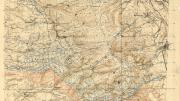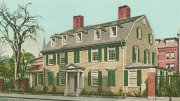In a Veterans Day service at Memorial Church on November 11, Ronald Sobel, senior rabbi of Congregation Emanu-El, New York City, spoke of the nature of liberalism, which descended "like a sunbeam" when universities came into being after the Dark Ages. Following Sobel's talk, Rev. Peter J. Gomes, B.D. '68, Plummer professor of Christian morals and Pusey minister in the Memorial Church, called attention to a newly installed tablet honoring three Radcliffe alumnae who died in service as nurses in World War I.
The women could not be memorialized in Memorial Church when it was dedicated on November 11, 1932, because Radcliffe was not part of Harvard. The church sought to "improve upon the judgment of our predecessors," said Gomes in the week before the tablet was unveiled. "This is an obligation of memory long overdue."
The women whose names are inscribed on the tablet are Lucy Nettie Fletcher '10, Ruth Holden '11, and Helen Homans, a special student between 1908 and 1913.
Fletcher was born on the island of Jersey in 1886 and came to America when she was 16. After Radcliffe she trained as a nurse at Massachusetts General Hospital and then went with the hospital unit to France in 1917. She died the next year of cerebro-spinal meningitis. The chaplain, later bishop of Massachusetts, who conducted her funeral service said, "It was her tireless work and devotion to duty that resulted in her death."
Holden was born in Attleboro, Massachusetts. She won the Fay Prize at Radcliffe, for "the student making the greatest progress in the four undergraduate years." She did postgraduate work in botany at Cambridge University and was elected a fellow of Newnham College. Unable as an American national to join Britain's war effort as a nurse, she enrolled with a medical unit organized for the relief of Russian refugees. Many of them were seriously ill. She contracted a fatal infection, died in 1917, and was buried in Kazan, Russia.
Homans was a Bostonian and descendant of John Adams. She served as a nurse in France from 1915 until her death from influenza in 1918, less than a week before the armistice. She was awarded the Croix de Guerre before her death. On her coffin were the words "Morte Pour La France."
The names of Harvard men who died in World War I may be read on the walls of the memorial room at the south side of the church. Victims of World War II are named on the south wall of the sanctuary, the main body of the church. The new tablet is on the north wall of the sanctuary, with three others, and is closest to the pulpit. The other tablets commemorate German alumni of Harvard who fought for their country in World War I and alumni who died in the Korean and Vietnam Wars.





